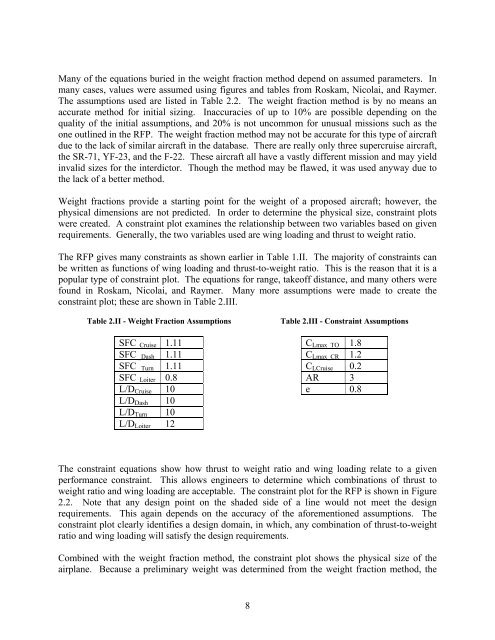SAWE Report - Cal Poly San Luis Obispo
SAWE Report - Cal Poly San Luis Obispo
SAWE Report - Cal Poly San Luis Obispo
Create successful ePaper yourself
Turn your PDF publications into a flip-book with our unique Google optimized e-Paper software.
Many of the equations buried in the weight fraction method depend on assumed parameters. In<br />
many cases, values were assumed using figures and tables from Roskam, Nicolai, and Raymer.<br />
The assumptions used are listed in Table 2.2. The weight fraction method is by no means an<br />
accurate method for initial sizing. Inaccuracies of up to 10% are possible depending on the<br />
quality of the initial assumptions, and 20% is not uncommon for unusual missions such as the<br />
one outlined in the RFP. The weight fraction method may not be accurate for this type of aircraft<br />
due to the lack of similar aircraft in the database. There are really only three supercruise aircraft,<br />
the SR-71, YF-23, and the F-22. These aircraft all have a vastly different mission and may yield<br />
invalid sizes for the interdictor. Though the method may be flawed, it was used anyway due to<br />
the lack of a better method.<br />
Weight fractions provide a starting point for the weight of a proposed aircraft; however, the<br />
physical dimensions are not predicted. In order to determine the physical size, constraint plots<br />
were created. A constraint plot examines the relationship between two variables based on given<br />
requirements. Generally, the two variables used are wing loading and thrust to weight ratio.<br />
The RFP gives many constraints as shown earlier in Table 1.II. The majority of constraints can<br />
be written as functions of wing loading and thrust-to-weight ratio. This is the reason that it is a<br />
popular type of constraint plot. The equations for range, takeoff distance, and many others were<br />
found in Roskam, Nicolai, and Raymer. Many more assumptions were made to create the<br />
constraint plot; these are shown in Table 2.III.<br />
Table 2.II - Weight Fraction Assumptions<br />
SFC _Cruise 1.11<br />
SFC _Dash 1.11<br />
SFC _Turn 1.11<br />
SFC _Loiter 0.8<br />
L/D Cruise 10<br />
L/D Dash 10<br />
L/D Turn 10<br />
L/D Loiter 12<br />
Table 2.III - Constraint Assumptions<br />
C Lmax_TO 1.8<br />
C Lmax_CR 1.2<br />
C LCruise 0.2<br />
AR 3<br />
e 0.8<br />
The constraint equations show how thrust to weight ratio and wing loading relate to a given<br />
performance constraint. This allows engineers to determine which combinations of thrust to<br />
weight ratio and wing loading are acceptable. The constraint plot for the RFP is shown in Figure<br />
2.2. Note that any design point on the shaded side of a line would not meet the design<br />
requirements. This again depends on the accuracy of the aforementioned assumptions. The<br />
constraint plot clearly identifies a design domain, in which, any combination of thrust-to-weight<br />
ratio and wing loading will satisfy the design requirements.<br />
Combined with the weight fraction method, the constraint plot shows the physical size of the<br />
airplane. Because a preliminary weight was determined from the weight fraction method, the<br />
8













